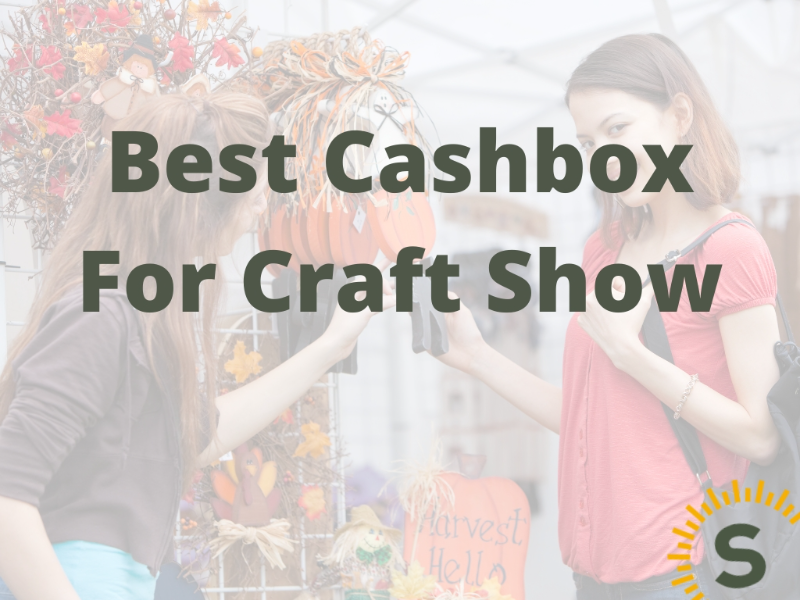
If you're attending craft shows, you're going to see a mixture of customers paying in cash as well as credit. As such, you need to be prepared to handle whatever cash you're given, as well as have an organised system that can deal with change.
That is why using a 'cashbox for craft show' is essential.
A cashbox is a simple solution that provides several solutions to problems you will face.
Firstly, security: you can keep any change locked away out of reach from anyone passing by.
Secondly, some of the better models help keep your coins organised, which can speed up how quickly you handle clients, leading to better customer service and shorter queue times. Thirdly, it's a safe place to keep the cash until you manage to get to the bank to deposit it.
There is an alternative to using a cashbox, which would be just using a bumbag. Depending on how much change you're expecting to handle, your needs for a cashbox might be slightly different. To help you make a decision on which cashbox is best for your craft show, we have broken down the three best options for you. These options vary based on low to high expectations of transactions, while also factoring in costs.
If cash boxes aren't your thing, and you only need a safe space to keep a small amount of notes and coins throughout the day, perhaps a "fanny/bum" bag would be suitable. They're a similar price to the Deskit Cashbox but the difference is that a bag is strapped to your waist. This makes it super convenient to handle cash as you continue to service your customers.
As a vendor at a craft show, you'll need to plan your cash needs carefully to ensure smooth transactions with customers. Here are some tips to help you manage cash as a vendor:
Start the day with an adequate amount of change in various denominations. You'll need smaller bills and coins to provide change to customers who pay with larger bills.
Price your items in a way that minimizes the need for giving back a lot of change. If most of your products are priced at round numbers or convenient price points, it will make transactions easier.
Use a secure cash box or a cash register to keep your money safe throughout the event. Avoid leaving cash unattended and periodically move excess cash to a more secure location.
Consider accepting credit cards or mobile payments to provide customers with additional payment options. This can increase sales and reduce the reliance on cash.
Keep track of all your sales and expenses, including cash transactions. This will help you reconcile your cash at the end of the day and keep accurate records for tax purposes.
If possible, have a small amount of cash set aside as a "float" to start the day. This will ensure you have change on hand from the beginning of the event.
Keep your cash and coins neatly organised in your cash box to avoid confusion during transactions.
Be aware of your surroundings and take precautions to prevent theft or fraud. Avoid leaving your cash box unattended and consider having a helper to watch over your booth during busy times.
Clearly display the prices of your products so customers know exactly how much they need to pay, reducing the likelihood of disputes or confusion.
If you run out of change during the event, try to replenish your cash from a nearby ATM or get change from other vendors who might be willing to help.
Remember, every craft show is different, so it's essential to assess your specific needs and make adjustments based on the expected crowd and the price range of your products. Keeping a well-organised cash management system will help you focus on making sales and create a positive experience for your customers.
For a craft show, bring enough cash for providing change, covering expenses, and potential sales. Aim for a few hundred dollars in small bills and coins, considering product prices, expected attendance, and available payment options. Prioritise security by using a secure cash box and replenishing funds if needed.
To track sales at a craft show, use different methods. Give receipts or invoices to customers. Keep a paper tally sheet or use a tablet/laptop to note each sale. Consider using a smartphone app or a portable card reader for credit card payments. If you have barcodes on products, use a barcode scanner. Try craft show sales software or a cash register with sales reports. Categorise sales by item type. Keep records and cash secure. At the end of the day, summarise total sales for insights. Proper tracking helps understand your craft show success and customer preferences.
In conclusion, for craft show vendors seeking a reliable and efficient cash management solution, the Burg Wachter CB03GBBK 10" cash box stands out as the ideal choice. Its independent coin and note space, portability, organised coin tray, secure locking mechanism, and affordable price make it a top-notch option. With the Burg Wachter cash box, vendors can handle transactions smoothly, enhance customer service, and maintain the safety of their earnings. Investing in this well-designed cash box ensures a successful and organised craft show experience.
Read More:

Stuart is an expert in Property, Money, Banking & Finance, having worked in retail and investment banking for 10+ years before founding Sunny Avenue. Stuart has spent his career studying finance. He holds qualifications in financial studies, mortgage advice & practice, banking operations, dealing & financial markets, derivatives, securities & investments.





Our website offers information about financial products such as investing, savings, equity release, mortgages, and insurance. None of the information on Sunny Avenue constitutes personal advice. Sunny Avenue does not offer any of these services directly and we only act as a directory service to connect you to the experts. If you require further information to proceed you will need to request advice, for example from the financial advisers listed. If you decide to invest, read the important investment notes provided first, decide how to proceed on your own basis, and remember that investments can go up and down in value, so you could get back less than you put in.
Think carefully before securing debts against your home. A mortgage is a loan secured on your home, which you could lose if you do not keep up your mortgage payments. Check that any mortgage will meet your needs if you want to move or sell your home or you want your family to inherit it. If you are in any doubt, seek independent advice.